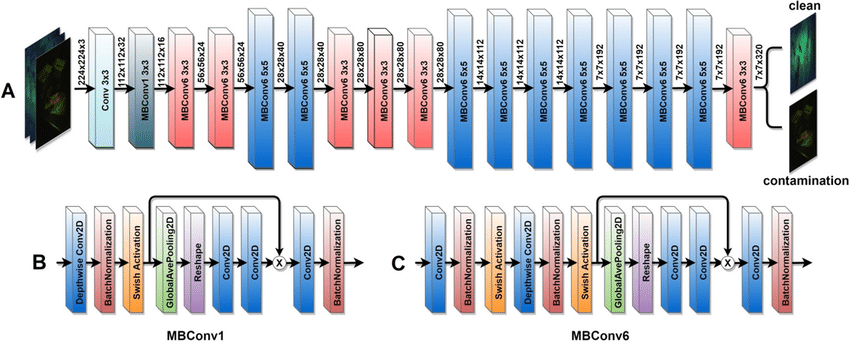EfficientNet¶
ConvNet Image Classification
- class lucid.models.EfficientNet(num_classes: int = 1000, width_coef: float = 1.0, depth_coef: float = 1.0, scale: float = 1.0, dropout: float = 0.2, se_scale: int = 4, stochastic_depth: bool = False, p: float = 0.5)¶
The EfficientNet class implements a scalable and efficient convolutional neural network architecture that can be configured to encompass all EfficientNet-B0 to B7 variants.

Class Signature¶
class EfficientNet(nn.Module):
def __init__(
self,
num_classes: int = 1000,
width_coef: float = 1.0,
depth_coef: float = 1.0,
scale: float = 1.0,
dropout: float = 0.2,
se_scale: int = 4,
stochastic_depth: bool = False,
p: float = 0.5,
) -> None
Parameters¶
num_classes (int, optional): Number of output classes for the final classification layer. Defaults to 1000 (e.g., for ImageNet).
width_coef (float, optional): Coefficient to scale the width (number of channels) of the network. Defaults to 1.0.
depth_coef (float, optional): Coefficient to scale the depth (number of layers) of the network. Defaults to 1.0.
scale (float, optional): Global scaling factor applied to the input resolution. Defaults to 1.0.
dropout (float, optional): Dropout rate applied to the final fully connected layer. Defaults to 0.2.
se_scale (int, optional): Reduction ratio for the squeeze-and-excitation (SE) block. Defaults to 4.
stochastic_depth (bool, optional): Whether to use stochastic depth regularization. Defaults to False.
p (float, optional): Probability for stochastic depth when enabled. Defaults to 0.5.
Configurations¶
The following table summarizes the configurations for EfficientNet variants B0 to B7:
Variant |
Width Coefficient |
Depth Coefficient |
Input Resolution |
Dropout Rate |
|---|---|---|---|---|
B0 |
1.0 |
1.0 |
224x224 |
0.2 |
B1 |
1.0 |
1.1 |
240x240 |
0.2 |
B2 |
1.1 |
1.2 |
260x260 |
0.3 |
B3 |
1.2 |
1.4 |
300x300 |
0.3 |
B4 |
1.4 |
1.8 |
380x380 |
0.4 |
B5 |
1.6 |
2.2 |
456x456 |
0.4 |
B6 |
1.8 |
2.6 |
528x528 |
0.5 |
B7 |
2.0 |
3.1 |
600x600 |
0.5 |
Examples¶
from lucid.models import EfficientNet
# Instantiate EfficientNet-B0
model_b0 = EfficientNet(num_classes=1000, width_coef=1.0, depth_coef=1.0, scale=1.0)
# Forward pass with a random input
input_tensor = lucid.random.randn(1, 3, 224, 224) # Batch size of 1, ImageNet resolution
output = model_b0(input_tensor)
print(output.shape) # Output shape: (1, 1000)
# Instantiate EfficientNet-B7
model_b7 = EfficientNet(num_classes=1000, width_coef=2.0, depth_coef=3.1, scale=2.0)
# Forward pass
input_tensor = lucid.random.randn(1, 3, 600, 600) # Larger resolution for B7
output = model_b7(input_tensor)
print(output.shape) # Output shape: (1, 1000)